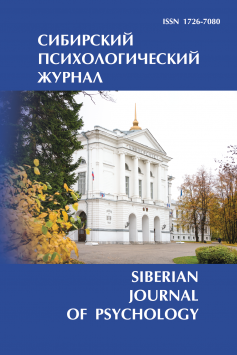Selective perception of deceptive messages in dependence to the gender
The complication of information technology leads to the fact that today a person faces the problem of forming and maintaining an adequate attitude and perception of information messages. In the general information flow, elements of truth and deception are combined meaningfully. A number of specialists carried out studies of gender, sex differences and their impact on the ability to detect deception. We understand perceptual strategies as relationships, as trends that arise when interacting with a message. The trends characterize selectivity, which is described by means of the concepts of a semantic center and a vector of perception. We understand the strategy of deception perception as a psychological system, which have a tendency to self-organization, complicacy and openness. We singled out four types of semantic centers. The motivational semantic center is defined by the criteria of interest and involvement. The cognitive center is defined by the criteria of understanding and logic. The criteria that determine the affective center are experience and emotion, and for the authentic center the criteria are trust and realism. The sample included 60 people, 30 women and 30 men. We offered them to compare two text messages and evaluate them according to eight parameters of perception. There were 4 consecutive operations on the parameters: ranging the parameters, estimating the texts, selecting the parameters for adequate perception and then secondary ranging of the selected parameters. The experiment demonstrated that there are common and distinctive features in perception strategies for deceptive messages for men and women. A common feature is motivational cognitive selectivity and orientation. They are expressed in the respective motivational and cognitive centers and vectors of perception. The difference is in the adequacy level of ascertaining text perception strategy. The perception strategies of female respondents were characterized by a high and very high level of adequacy. The perceptual strategies of male respondents were characterized by a high and medium level of adequacy. As a result of the conducted research, we revealed and described the trends to self-organization and openness of deceptive messages perception. The trend to self-perception was expressed in the semantic structuring of the deceptive message content. The trend to openness of perception was expressed in the increasing number and type of orientations in the strategies. The trends to self-organization and openness of perception are the main characteristics of the subject's selectivity with respect to deceptive messages.
Keywords
пол, стратегия восприятия, отношение, смысловой узел, вектор, направленность, избирательность, ложь, sex, perceptual strategy, attitude, semantic center, vector, focus, selectivity, deceptionAuthors
| Name | Organization | |
| Egorov Dmitry M. | Tomsk State University | e_dima@bk.ru |
References
Selective perception of deceptive messages in dependence to the gender | Sibirskiy Psikhologicheskiy Zhurnal – Siberian Journal of Psychology. 2018. № 68. DOI: 10.17223/17267080/68/3
